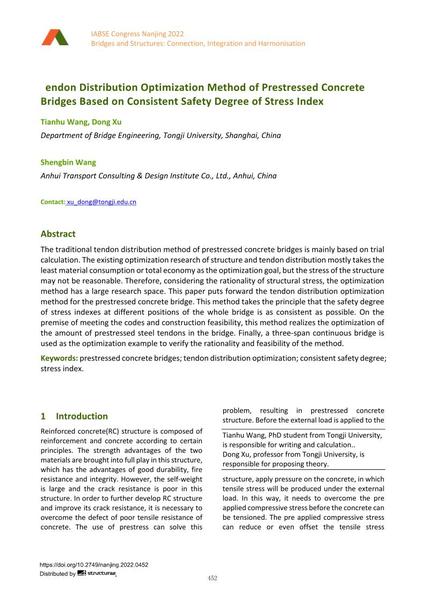Tendon Distribution Optimization Method of Prestressed Concrete Bridges Based on Consistent Safety Degree of Stress Index

|
|
|||||||||||
Bibliografische Angaben
| Autor(en): |
Tianhu Wang
(Department of Bridge Engineering, Tongji University, Shanghai, China)
Dong Xu (Department of Bridge Engineering, Tongji University, Shanghai, China) Shengbin Wang (Anhui Transport Consulting & Design Institute Co., Ltd., Anhui, China) |
||||
|---|---|---|---|---|---|
| Medium: | Tagungsbeitrag | ||||
| Sprache(n): | Englisch | ||||
| Tagung: | IABSE Congress: Bridges and Structures: Connection, Integration and Harmonisation, Nanjing, People's Republic of China, 21-23 September 2022 | ||||
| Veröffentlicht in: | IABSE Congress Nanjing 2022 | ||||
|
|||||
| Seite(n): | 452-460 | ||||
| Anzahl der Seiten (im PDF): | 9 | ||||
| DOI: | 10.2749/nanjing.2022.0452 | ||||
| Abstrakt: |
The traditional tendon distribution method of prestressed concrete bridges is mainly based on trial calculation. The existing optimization research of structure and tendon distribution mostly takes the least material consumption or total economy as the optimization goal, but the stress of the structure may not be reasonable. Therefore, considering the rationality of structural stress, the optimization method has a large research space. This paper puts forward the tendon distribution optimization method for the prestressed concrete bridge. This method takes the principle that the safety degree of stress indexes at different positions of the whole bridge is as consistent as possible. On the premise of meeting the codes and construction feasibility, this method realizes the optimization of the amount of prestressed steel tendons in the bridge. Finally, a three-span continuous bridge is used as the optimization example to verify the rationality and feasibility of the method. |
||||
| Stichwörter: |
Spannbetonbrücken
|
||||
| Copyright: | © 2022 International Association for Bridge and Structural Engineering (IABSE) | ||||
| Lizenz: | Die Urheberrechte (Copyright) für dieses Werk sind rechtlich geschützt. Es darf nicht ohne die Zustimmung des Autors/der Autorin oder Rechteinhabers/-in weiter benutzt werden. |
||||
